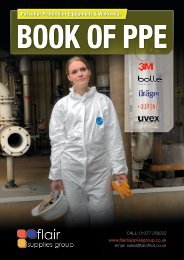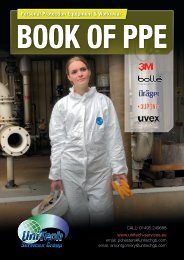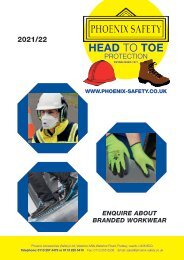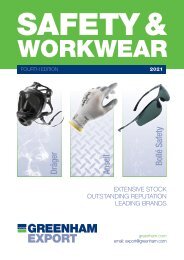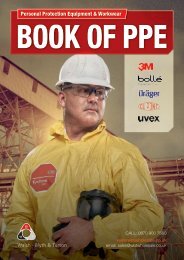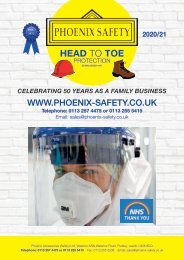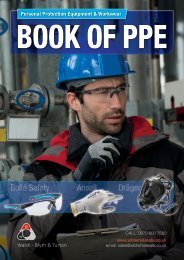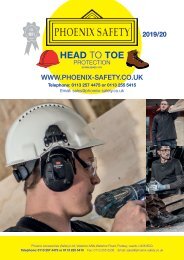Create successful ePaper yourself
Turn your PDF publications into a flip-book with our unique Google optimized e-Paper software.
Hand Protection<br />
34<br />
Buying Guide<br />
Health & safety for<br />
your hands<br />
Hands at work are extremely vulnerable to<br />
a wide range <strong>of</strong> hazards which include cuts,<br />
blows, chemical attack and temperature<br />
extremes. With industry’s increasingly<br />
complex and sensitive manufacturing and<br />
handling processes, there is a growing<br />
insistence on the use <strong>of</strong> “job fitted” gloves<br />
that meet each user’s specific requirements.<br />
The importance <strong>of</strong><br />
glove maintenance<br />
Contaminated and damaged gloves may fail<br />
to protect the hands from the very hazard<br />
they were designed for. Effective protection<br />
is maintained by regular replacement <strong>of</strong> the<br />
gloves. Check the condition <strong>of</strong> the gloves,<br />
inside and out before use..<br />
Safety standards symbols<br />
and what they each<br />
represent<br />
What to look out for<br />
Each glove has its own individual<br />
rating for each standard it qualifies<br />
EN 388 for. Against each product there will<br />
be a prominent ‘standards box’<br />
(as per the example shown on the<br />
4X42B right) clearly displaying the particular<br />
safety standards that the glove<br />
complies with.<br />
This will help you quickly see what you need<br />
to know about the glove, helping you shop<br />
more efficiently.<br />
Your guide to safety<br />
standards and choosing the<br />
right hand protection<br />
European Standards<br />
Implies that the gloves comply with the<br />
basic requirements laid down by the EC<br />
Regulation: Personal Protective Equipment.<br />
Simple Design (Category I)<br />
For areas <strong>of</strong> ‘minimal risk’ where the<br />
effects <strong>of</strong> not wearing a glove are easily<br />
reversible or superficial. Such products are<br />
self-certified.<br />
Intermediate Design (Category II)<br />
For areas <strong>of</strong> specific risk i.e. mechanical<br />
risks. Such products will have been EC type<br />
tested against European test methods and<br />
certified by a notified body.<br />
Complex Design (Category III)<br />
For areas/applications that can seriously or<br />
irreversibly harm the health. Such products,<br />
in addition to the CE type test, will also<br />
have to be either produced under an<br />
approved quality system OR be type tested<br />
on an annual basis.<br />
What the symbols represent<br />
JKLOPT<br />
JKL<br />
EN 388 – This standard applies to all kinds <strong>of</strong> protective gloves giving<br />
protection from mechanical risks, in respect <strong>of</strong> physical problems caused<br />
by abrasion, blade cut, tearing, puncture or impact. This standard also<br />
covers risk <strong>of</strong> electrostatic discharge.<br />
EN ISO374-5:2016 – Gloves have been tested for penetration (leakage)<br />
using test method in EN 374-2:2014 but do not need to be tested<br />
against chemical permeation. If the word VIRUS appears under the<br />
symbol, this signifies protection against bacteria, fungi and viruses. If the<br />
word Virus is not present, then only protection against bacteria and fungi<br />
is claimed. Such gloves may not protect against all viruses.<br />
EN ISO374-1:2016/Type A – The permeation performance shall be at<br />
least level 2 (minimum 30 mins breakthrough time) against a minimum<br />
<strong>of</strong> 6 test chemicals.<br />
EN ISO374-1:2016/Type B – The permeation performance shall be at<br />
least level 2 (minimum 30 mins breakthrough time) against a minimum<br />
<strong>of</strong> 3 test chemicals.<br />
EN ISO374-1:2016/Type C – The permeation performance shall be at<br />
least level 1 (minimum 10 mins breakthrough time) against a minimum<br />
<strong>of</strong> 1 test chemicals.<br />
EN 511 – This standard applies to gloves which protect the hands<br />
against convective and contact cold.<br />
EN 407 – This standard specifies thermal performance for protective<br />
gloves against heat and/or fire.<br />
EN 659 – This standard defines performance requirements for gloves<br />
designed to protect fire fighters against heat and flames.<br />
EN 421 – This standard lays down test methods and performance<br />
criteria for gloves <strong>of</strong>fering protection against ionising radiation and<br />
radioactive contamination.<br />
EN 455 – Medical gloves for single use.<br />
If a glove is to be used for food handling, it is required to carry either the<br />
words ‘for food use’ or this symbol.<br />
What the numbers represent<br />
Contact Heat<br />
A sample is taken from the palm area <strong>of</strong> a glove. The outside <strong>of</strong> the glove is put<br />
on a hot surface and the temperature <strong>of</strong> the inside <strong>of</strong> the glove is then monitored.<br />
The temperature on the inside <strong>of</strong> the glove must take 15 seconds or more to rise<br />
by 10°C from room temperature.<br />
EN 407 Performance<br />
Level<br />
3243AP<br />
A B C D<br />
Mechanical Hazards: EN 388<br />
Performance Level<br />
(a) Abrasion resistance 0-4<br />
(b) Blade-cut resistance 0-5<br />
(c) Tear resistance 0-4<br />
(d) Puncture resistance 0-4<br />
(e) Straight blade cut (TDM) resistance A-F (f) Impact resistance P if passes<br />
An “X” can be shown in place <strong>of</strong> any <strong>of</strong> the first 5 digits underneath the<br />
pictogram, where the test was either not carried out, not required or not suitable.<br />
The same method applies to these two standards below also.<br />
Thermal Hazards: EN 407<br />
Performance Level<br />
(a) Burning behaviour 0-4<br />
(b) Contact heat 0-4<br />
(c) Convective heat 0-4<br />
(d) Radiant heat 0-4<br />
(e) Small splashes <strong>of</strong> molten metal 0-4<br />
(f) Large splashes <strong>of</strong> molten metal 0-4<br />
Contact<br />
Temperature °C<br />
1 100 >15<br />
2 250 >15<br />
3 350 >15<br />
4 500 >15<br />
Threshold Time<br />
Seconds<br />
EN 511: Cold<br />
Performance Level<br />
(a) Resistance to convection cold 0-4<br />
(b) Resistance to contact cold 0-4<br />
(c) Permeability to water 0-1<br />
TAKE NOTE...<br />
CHANGES ARE HERE<br />
CHANGES TO EC STANDARD EN 388<br />
During 2016 a new version <strong>of</strong> EN 388, Protection against<br />
Mechanical Hazards, was published. It allows products<br />
<strong>of</strong>fering higher classifications <strong>of</strong> cut levels to be identified.<br />
What changed<br />
Any sample tested for cut resistance using the existing<br />
coup method, which blunts the blade used in the test, will<br />
have to be additionally tested using the ISO cut method.<br />
LEVEL<br />
A<br />
LEVEL<br />
B<br />
LEVEL<br />
C<br />
LEVEL<br />
D<br />
LEVEL<br />
E<br />
LEVEL<br />
F<br />
2 5 10 15 22 30<br />
Back <strong>of</strong> hand protection (impact protection testing) is<br />
now included.<br />
3 means the sample achieved<br />
level 3 for abrasion<br />
4 means the sample achieved<br />
level 4 for coup cut<br />
4 means the sample achieved<br />
level 4 for tear<br />
3443AP 3 means the sample achieved<br />
level 3 puncture<br />
A means the sample achieved level A for ISO cut which<br />
was tested due to blade blunting during the coup test<br />
P means the sample passes requirements for impact<br />
protection<br />
What it means to you<br />
• This change only affects new products being certified<br />
once the standard has been published<br />
• As with any new <strong>PPE</strong> standard, it does not apply<br />
retrospectively<br />
• Over the next few years, you will see more and more<br />
products carrying this standard<br />
• It will allow products <strong>of</strong>fering higher levels <strong>of</strong> cut<br />
protection to be identified<br />
• EN420: General requirements for Protective Gloves –<br />
New Test Method being added (prEN 16778) for the<br />
determination <strong>of</strong> the presence <strong>of</strong> Dimethylformamide<br />
(DMF), a toxic ingredient <strong>of</strong> insecticide sometimes used in<br />
the leather tanning process



